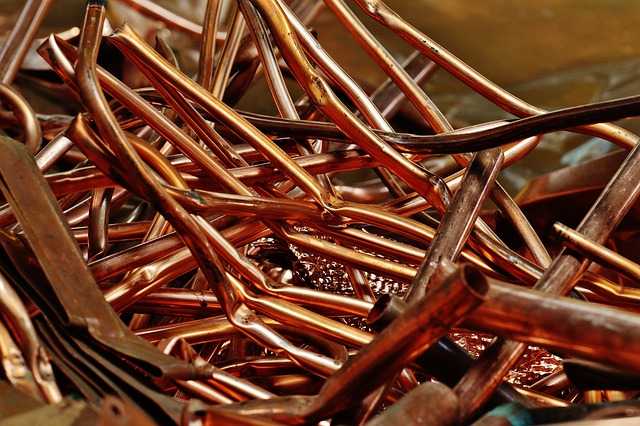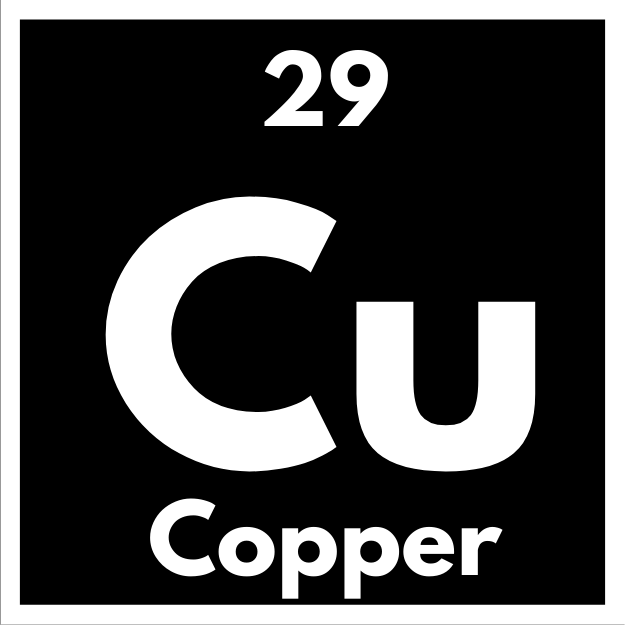Cu and atomic number 29. It is a soft, malleable, and ductile metal with very high thermal and electrical conductivity. A freshly exposed surface of pure copper has a pinkish-orange color.
Symbol: Cu
Atomic mass: 63.546 u
Atomic number: 29
Electron configuration: [Ar] 3d¹⁰4s¹
Density: 8.96 g/cm³ (Near room temperature)
Melting point: 1,085 °C
CAS ID: 7440-50-8
List of facts
Copper is a chemical element with the symbol Cu
Copper has an atomic number of 29.
A freshly exposed surface of pure copper has a pinkish-orange color
Copper is one of the few metals that can occur in nature in a directly usable metallic form
In the Roman era, copper was mined on Cyprus, the origin of the name of the metal, from aes cyprium (metal of Cyprus), later corrupted to cuprum in Latin.
Copper is one of a few metallic elements with a natural color other than gray or silver
In humans, copper is found mainly in the liver, muscle, and bone.
The adult body contains between 1.4 and 2.1 mg of copper per kilogram of body weight.

If copper is put in contact with another metal, galvanic corrosion will occur
Pure copper is orange-red and acquires a reddish tarnish when exposed to air.
A green layer of verdigris (copper carbonate) can often be seen on old copper structures
the Statue of Libertyis an example with a layer of verdigris
There are 29 isotopes of copper
63Cu and 65Cu are stable, with 63Cu comprising approximately 69% of naturally occurring copper
Copper is produced in massive stars
It is present in the Earth’s crust in a proportion of about 50 parts per million (ppm)
The largest mass of elemental copper discovered weighed 420 tonnes and was found in 1857 on the Keweenaw Peninsula in Michigan, US
A Dead Sea Scroll was found to be inscribed on a piece of copper instead of the traditional parchment.
Copper is the 25th most abundant element in Earth’s crust, representing 50 ppm compared with 75 ppm for zinc, and 14 ppm for lead
in 2005, Chile was the top producer of copper with at least one-third of the world share followed by the United States, Indonesia and Peru
Copper has been in use at least 10,000 years
More than 95% of all copper ever mined and smelted has been extracted since 1900
The total amount of copper on Earth is vast, with around 1014 tons in the top kilometer of Earth’s crus
Copper is recyclable without any loss of quality, both from raw state and from manufactured products
In volume, copper is the third most recycled metal after iron and aluminium
An estimated 80% of all copper ever mined is still in use today
Egyptians indicated copper in their hieroglyph system using the ankh symbol.
The element is also essential for the development and growth of fetuses and new-born babies.
Brass is an alloy of copper and zinc

Bronze usually refers to copper-tin alloys, but can refer to any alloy of copper such as aluminium bronze
Some lead-free solders consist of tin alloyed with a small proportion of copper and other metals
The alloy of copper and nickel, called cupronickel, is used in low-denomination coins, often for the outer cladding
The US five-cent coin (currently called a nickel) consists of 75% copper and 25% nickel in homogeneous composition.
The United States used an alloy of 90% silver and 10% copper until 1965 in their coins
The history of copper use dates to 9000 BC in the Middle East
A copper pendant was found in northern Iraq that dates to 8700 BC
The Great Copper Mountain mine in Falun, Sweden satisfied two-thirds of Europe’s copper consumption in the 17th century
Sweden used to have a copper backed currency
The major applications of copper are electrical wire (60%), roofing and plumbing (20%), and industrial machinery (15%)
For more than two centuries, copper paint has been used on boat hulls to control the growth of plants and shellfish
Copper wire is used in power generation, power transmission, power distribution, telecommunications, electronics circuitry, and countless types of electrical equipment.
Electromagnets, vacuum tubes, cathode ray tubes, and magnetrons in microwave ovens use copper, as do waveguides for microwave radiation
Copper usage averages up to five times more in renewable energy systems than in traditional power generation, such as fossil fuel and nuclear power plants
According to the United States Geological Survey, in-ground copper reserves have increased more than 700% since 1950, from almost 100 million tonnes to 720 million tonnes in 2017
Coppers recycling rate is higher than any other metal
Copper-alloy touch surfaces have natural properties that destroy a wide range of microorganisms
Copper doorknobs are used by hospitals to reduce the transfer of disease, and Legionnaires’ disease is suppressed by copper tubing in plumbing systems
Copper properties
| Atomic number (Z) | 29 | ||||||||||||||
|---|---|---|---|---|---|---|---|---|---|---|---|---|---|---|---|
| Group | group 11 | ||||||||||||||
| Period | period 4 | ||||||||||||||
| Block | d-block | ||||||||||||||
| Electron configuration | [Ar] 3d10 4s1 | ||||||||||||||
| Electrons per shell | 2, 8, 18, 1 | ||||||||||||||
Physical properties |
|||||||||||||||
| Phase at STP | solid | ||||||||||||||
| Melting point | 1357.77 K (1084.62 °C, 1984.32 °F) | ||||||||||||||
| Boiling point | 2835 K (2562 °C, 4643 °F) | ||||||||||||||
| Density (near r.t.) | 8.96 g/cm3 | ||||||||||||||
| when liquid (at m.p.) | 8.02 g/cm3 | ||||||||||||||
| Heat of fusion | 13.26 kJ/mol | ||||||||||||||
| Heat of vaporization | 300.4 kJ/mol | ||||||||||||||
| Molar heat capacity | 24.440 J/(mol·K) | ||||||||||||||
Vapor pressure
|
|||||||||||||||
Atomic properties |
|||||||||||||||
| Oxidation states | −2, 0,[2] +1, +2, +3, +4 (a mildly basic oxide) | ||||||||||||||
| Electronegativity | Pauling scale: 1.90 | ||||||||||||||
| Ionization energies |
|
||||||||||||||
| Atomic radius | empirical: 128 pm | ||||||||||||||
| Covalent radius | 132±4 pm | ||||||||||||||
| Van der Waals radius | 140 pm | ||||||||||||||
|
|
|||||||||||||||
Other properties |
|||||||||||||||
| Natural occurrence | primordial | ||||||||||||||
| Crystal structure | face-centered cubic (fcc) | ||||||||||||||
| Speed of sound thin rod | (annealed) 3810 m/s (at r.t.) |
||||||||||||||
| Thermal expansion | 16.5 µm/(m⋅K) (at 25 °C) | ||||||||||||||
| Thermal conductivity | 401 W/(m⋅K) | ||||||||||||||
| Electrical resistivity | 16.78 nΩ⋅m (at 20 °C) | ||||||||||||||
| Magnetic ordering | diamagnetic[3] | ||||||||||||||
| Molar magnetic susceptibility | −5.46×10−6 cm3/mol[4] | ||||||||||||||
| Young’s modulus | 110–128 GPa | ||||||||||||||
| Shear modulus | 48 GPa | ||||||||||||||
| Bulk modulus | 140 GPa | ||||||||||||||
| Poisson ratio | 0.34 | ||||||||||||||
| Mohs hardness | 3.0 | ||||||||||||||
| Vickers hardness | 343–369 MPa | ||||||||||||||
| Brinell hardness | 235–878 MPa | ||||||||||||||
| CAS Number | 7440-50-8 | ||||||||||||||

